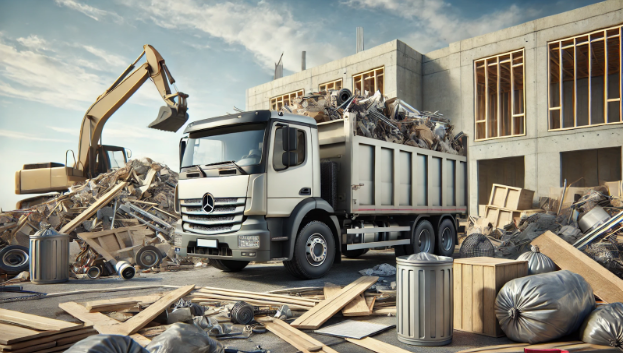
Construction Debris Removal: Efficient Solutions for a Cleaner Job Site
Construction projects produce a significant amount of debris, from wood scraps to concrete chunks. Proper construction debris removal is essential not only for keeping job sites clean and safe but also for ensuring environmentally responsible disposal. In this guide, we’ll explore practical solutions for managing construction debris efficiently, from DIY methods to professional services.
Why Construction Debris Removal is Important
Clearing out debris during and after construction projects is crucial for several reasons:
- Safety: Debris can be a safety hazard, creating risks for slips, trips, and falls on job sites.
- Efficiency: A clean worksite allows workers to move around freely, enhancing productivity.
- Environmental Responsibility: Many construction materials can be recycled, reducing the environmental impact.
- Professionalism: Keeping the site clean presents a professional image to clients and stakeholders.
Types of Construction Debris
Construction debris comes in many forms, and each type requires specific handling methods. Understanding these materials helps you plan for
removal and disposal.
| Type of Debris | Description | Common Disposal Methods |
|---|---|---|
| Wood Scraps | Lumber, plywood, and wood trim | Recycling or composting |
| Concrete and Asphalt | Heavier materials from foundations and pavement | Specialized recycling centers |
| Metals | Scrap metal, steel, and aluminum | Recycling for new materials |
| Drywall | Wallboard and gypsum board used in construction | Recycled into new drywall |
| Plastics | Packaging, pipes, and other plastic construction parts | Recycled if clean, or disposed properly |
| Bricks and Stone | Masonry debris from demolition or site prep | Reused or recycled as aggregate |
| Glass | Windows, doors, and other glass fixtures | Recycling if uncontaminated |
1. On-Site Sorting for Efficient Debris Management
Sorting debris directly at the site can save both time and money. Separating materials that can be recycled from those that require landfill disposal ensures efficient waste handling.
- How to Set Up Sorting: Use designated bins or piles for different materials, like wood, metal, and concrete.
- Benefits: Sorting at the source allows for easier recycling and disposal while reducing landfill impact.
- Tip: Label bins clearly to avoid cross-contamination, which can complicate recycling.
2. Renting a Dumpster for Large-Scale Projects
For large construction or renovation projects, renting a dumpster provides an easy way to manage waste. Here’s how to make the most of this option:
- How It Works: A dumpster rental company drops off a dumpster at the site. You fill it with debris, and they pick it up once it’s full.
- Best For: Large or ongoing projects with significant waste, such as home renovations or commercial builds.
- Considerations: Choose the right size, as overfilling can lead to extra fees.
3. Recycling and Reusing Construction Materials
Recycling is one of the most environmentally responsible ways to handle construction debris. Many materials, including metals, concrete, and drywall, can be recycled or reused.
- Metal Recycling: Metals like steel and aluminum are highly recyclable and can be melted down to create new products.
- Concrete and Asphalt: Crushed concrete can be used as gravel, while asphalt can be recycled into new road materials.
- Wood and Drywall: Wood can often be repurposed or composted, while drywall can be broken down for new wallboards.
- Tip: Research local recycling facilities to see what materials they accept. Some facilities may even offer pickup for bulk loads.
4. Hiring a Professional Construction Debris Removal Service
Professional construction debris removal services handle all the heavy lifting and disposal for you. This option is ideal for larger jobs or companies needing quick, efficient cleanup.
- How It Works: A team arrives, removes the debris, and transports it to the appropriate recycling or disposal centers.
- Advantages: Saves time and ensures compliance with disposal regulations. Ideal for keeping the site clean and safe.
- Cost Considerations: Prices vary based on load size and type of materials. Bulk loads typically offer better rates.
Choosing the Right Debris Removal Service
When selecting a professional service, consider:
- Experience with Construction Debris: Look for services familiar with handling heavy and bulky materials.
- Recycling Commitment: Opt for companies with eco-friendly practices to ensure responsible disposal.
- Insurance and Licensing: Ensure the company is properly licensed and insured for safe and legal disposal.
FAQ: Construction Debris Removal
Q1: Can I dispose of construction debris on my own?
Yes, but it requires knowledge of local regulations and access to the right disposal facilities. For large projects, a dumpster rental or professional service is often more convenient.
Q2: Are there restrictions on what can be thrown in a dumpster?
Yes, hazardous materials like chemicals, asbestos, and paint are typically not allowed. Always check with your rental provider for a full list of restrictions.
Q3: Is it cheaper to recycle construction debris?
Recycling can save costs, especially for materials like metal. Many facilities offer lower rates for recyclable materials, and some even accept certain items for free.
Q4: How does debris removal affect the environment?
Responsible debris removal minimizes landfill waste and reduces the need for raw materials by promoting recycling and reuse.
